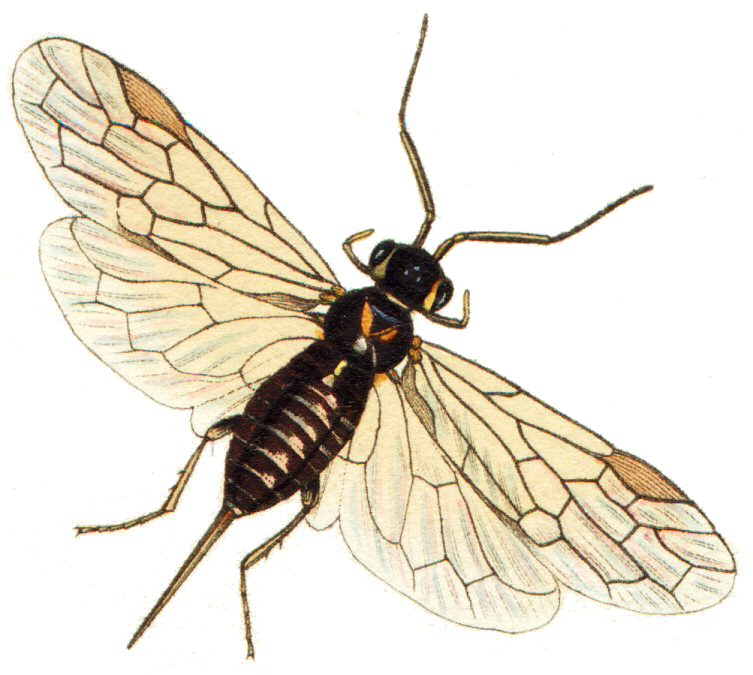|
Ampulicidae
The Ampulicidae, or cockroach wasps, are a small (about 170 species), primarily tropical family of sphecoid wasps, all of which use various cockroaches as prey for their larvae. They tend to have elongated jaws, pronounced neck-like constrictions behind the head, strongly petiolate abdomens, and deep grooves on the thorax. Many are quite ant-like in appearance, though some are brilliant metallic blue, green, and hot pink. Most species sting the roach more than once and in a specific way. The first sting is directed at nerve ganglia in the cockroach's thorax, temporarily paralyzing the victim for a few minutes - more than enough time for the wasp to deliver a second sting. The second sting is directed into a region of the cockroach's brain that controls the escape reflex, among other things. Piper, Ross (2007), ''Extraordinary Animals: An Encyclopedia of Curious and Unusual Animals'', Greenwood Press. When the cockroach has recovered from the first sting, it makes no attempt to f ... [...More Info...] [...Related Items...] OR: [Wikipedia] [Google] [Baidu] |
Ampulex Compressa
The emerald cockroach wasp or jewel wasp (''Ampulex compressa'') is a solitary wasp of the family Ampulicidae. It is known for its unusual reproductive behavior, which involves stinging a cockroach and using it as a host for its larvae. It thus belongs to the entomophagous parasites. Distribution The wasp is mostly found in the tropical regions of Africa, South Asia, Southeast Asia, and the Pacific islands. The flying wasps are more abundant in the warm seasons of the year. ''A. compressa'' was introduced to Hawaii by F.X. Williams in 1941 as a method of biocontrol. This has been unsuccessful because of the territorial tendencies of the wasp, and the small scale on which they hunt. The species is also found in the Brazilian states of São Paulo and Rio de Janeiro. ''A. compressa'' likely arrived in the country through the ports of Santos and Rio de Janeiro. Description The wasp has a metallic blue-green body, with the thighs of the second and third pair of legs red. The ... [...More Info...] [...Related Items...] OR: [Wikipedia] [Google] [Baidu] |
Ampulex
''Ampulex'' is a large cosmopolitan genus of wasps belonging to the family Ampulicidae. Most of the >130 species occur in the tropics, particularly in the Old World, and fewer than 15 are known from the New World; fewer than 5 species are native to Europe or the United States, though the Old World species '' Ampulex compressa'' has spread to virtually everywhere that its host roaches (esp. the genus '' Periplaneta'') can be found. The few species whose biology is known are parasitoids of cockroaches; they typically inject venom into the roach that subdues or immobilizes it, and then lay one to two eggs between the legs of the defenseless roach. Selected species *'' Ampulex canaliculata'' Say, 1823 *'' Ampulex compressa'' Fabricius, 1781 – jewel wasp or emerald cockroach wasp *''Ampulex dementor ''Ampulex dementor'' is a species of cockroach wasp native to Thailand, described in 2014 by Michael Ohl of the Museum für Naturkunde in Berlin, Germany Berlin ( , ) ... [...More Info...] [...Related Items...] OR: [Wikipedia] [Google] [Baidu] |
Ampulicidae
The Ampulicidae, or cockroach wasps, are a small (about 170 species), primarily tropical family of sphecoid wasps, all of which use various cockroaches as prey for their larvae. They tend to have elongated jaws, pronounced neck-like constrictions behind the head, strongly petiolate abdomens, and deep grooves on the thorax. Many are quite ant-like in appearance, though some are brilliant metallic blue, green, and hot pink. Most species sting the roach more than once and in a specific way. The first sting is directed at nerve ganglia in the cockroach's thorax, temporarily paralyzing the victim for a few minutes - more than enough time for the wasp to deliver a second sting. The second sting is directed into a region of the cockroach's brain that controls the escape reflex, among other things. Piper, Ross (2007), ''Extraordinary Animals: An Encyclopedia of Curious and Unusual Animals'', Greenwood Press. When the cockroach has recovered from the first sting, it makes no attempt to f ... [...More Info...] [...Related Items...] OR: [Wikipedia] [Google] [Baidu] |
Dolichurus
''Dolichurus'' is a genus of cockroach wasps in the family Ampulicidae; they are generally found on dead wood, leaf litter, or on tree trunks. There are at least 50 described species in ''Dolichurus''. These wasps are small in size with an elongate body and slender appendages; legs are modified for running. Sexual dimorphism is not marked; antennae have 12 segments in females and 13 segments in males; females have six visible metasomal segments and males usually have only three visible segments. In females metasomal punctures are usually fine, almost impunctate with very sparse delicate punctures (surface glossy) but the metasomal punctures of males are usually coarser. This is a cosmopolitan genus with about 50 species worldwide (Nearctic 1, Neotropical 2, Palearctic 6, Ethiopian 10, Oriental 27, and Australian 4). Latreille (1809) erected the genus ''Dolichurus'' (Hymenoptera: Ampulicidae) based on the type species ''Pompilus corniculus'' Spinola, 1808. Species These 50 speci ... [...More Info...] [...Related Items...] OR: [Wikipedia] [Google] [Baidu] |
Spheciformes
The Spheciformes is a paraphyletic assemblage of insect families which collectively comprise the "sphecoid wasps". Larvae are carnivorous. These are all the members of the superfamily Apoidea The superfamily Apoidea is a major group within the Hymenoptera, which includes two traditionally recognized lineages, the "sphecoid" wasps, and the bees. Molecular phylogeny demonstrates that the bees arose from within the traditional "Crabronida ..., which are not bees and which in older classifications were called the "Sphecoidea". Some are also described as mud daubers. The group is paraphyletic because the bees are believed to have arisen from a subgroup within the family Ammoplanidae, thus Spheciformes does not include all of the descendants of its common ancestor.Manuela Sann, Oliver Niehuis, Ralph S. Peters, Christoph Mayer, Alexey Kozlov, Lars Podsiadlowski, Sarah Bank, Karen Meusemann, Bernhard Misof, Christoph Bleidorn and Michael Ohl (2018) Phylogenomic analysis of Apoidea ... [...More Info...] [...Related Items...] OR: [Wikipedia] [Google] [Baidu] |
Apocrita Families
Apocrita is a suborder of insects in the order Hymenoptera. It includes wasps, bees, and ants, and consists of many families. It contains the most advanced hymenopterans and is distinguished from Symphyta by the narrow "waist" ( petiole) formed between the first two segments of the actual abdomen; the first abdominal segment is fused to the thorax, and is called the propodeum. Therefore, it is general practice, when discussing the body of an apocritan in a technical sense, to refer to the mesosoma and metasoma (or gaster) rather than the "thorax" and "abdomen", respectively. The evolution of a constricted waist was an important adaption for the parasitoid lifestyle of the ancestral apocritan, allowing more maneuverability of the female's ovipositor. The ovipositor either extends freely or is retracted, and may be developed into a stinger for both defense and paralyzing prey. Larvae are legless and blind, and either feed inside a host (plant or animal) or in a nest cell provis ... [...More Info...] [...Related Items...] OR: [Wikipedia] [Google] [Baidu] |
Insects Used As Insect Pest Control Agents
Insects (from Latin ') are pancrustacean hexapod invertebrates of the class Insecta. They are the largest group within the arthropod phylum. Insects have a chitinous exoskeleton, a three-part body (head, thorax and abdomen), three pairs of jointed legs, compound eyes and one pair of antennae. Their blood is not totally contained in vessels; some circulates in an open cavity known as the haemocoel. Insects are the most diverse group of animals; they include more than a million described species and represent more than half of all known living organisms. The total number of extant species is estimated at between six and ten million; In: potentially over 90% of the animal life forms on Earth are insects. Insects may be found in nearly all environments, although only a small number of species reside in the oceans, which are dominated by another arthropod group, crustaceans, which recent research has indicated insects are nested within. Nearly all insects hatch from eggs. Insect ... [...More Info...] [...Related Items...] OR: [Wikipedia] [Google] [Baidu] |
California Academy Of Sciences
The California Academy of Sciences is a research institute and natural history museum in San Francisco, California, that is among the largest museums of natural history in the world, housing over 46 million specimens. The Academy began in 1853 as a learned society and still carries out a large amount of original research. The institution is located at the Golden Gate Park in San Francisco. Completely rebuilt in 2008, the Academy's primary building in Golden Gate Park covers . In early 2020, before the COVID-19 pandemic, the California Academy of Sciences had around 500 employees and an annual revenue of about $33 million. Governance The California Academy of Sciences, California's oldest operating museum and research institution for the natural sciences, is governed by a forty-one member Board of Trustees who are nominated and chosen by the California Academy of Sciences Fellows California is a state in the Western United States, located along the Pacific Coast. Wit ... [...More Info...] [...Related Items...] OR: [Wikipedia] [Google] [Baidu] |
.jpg)


